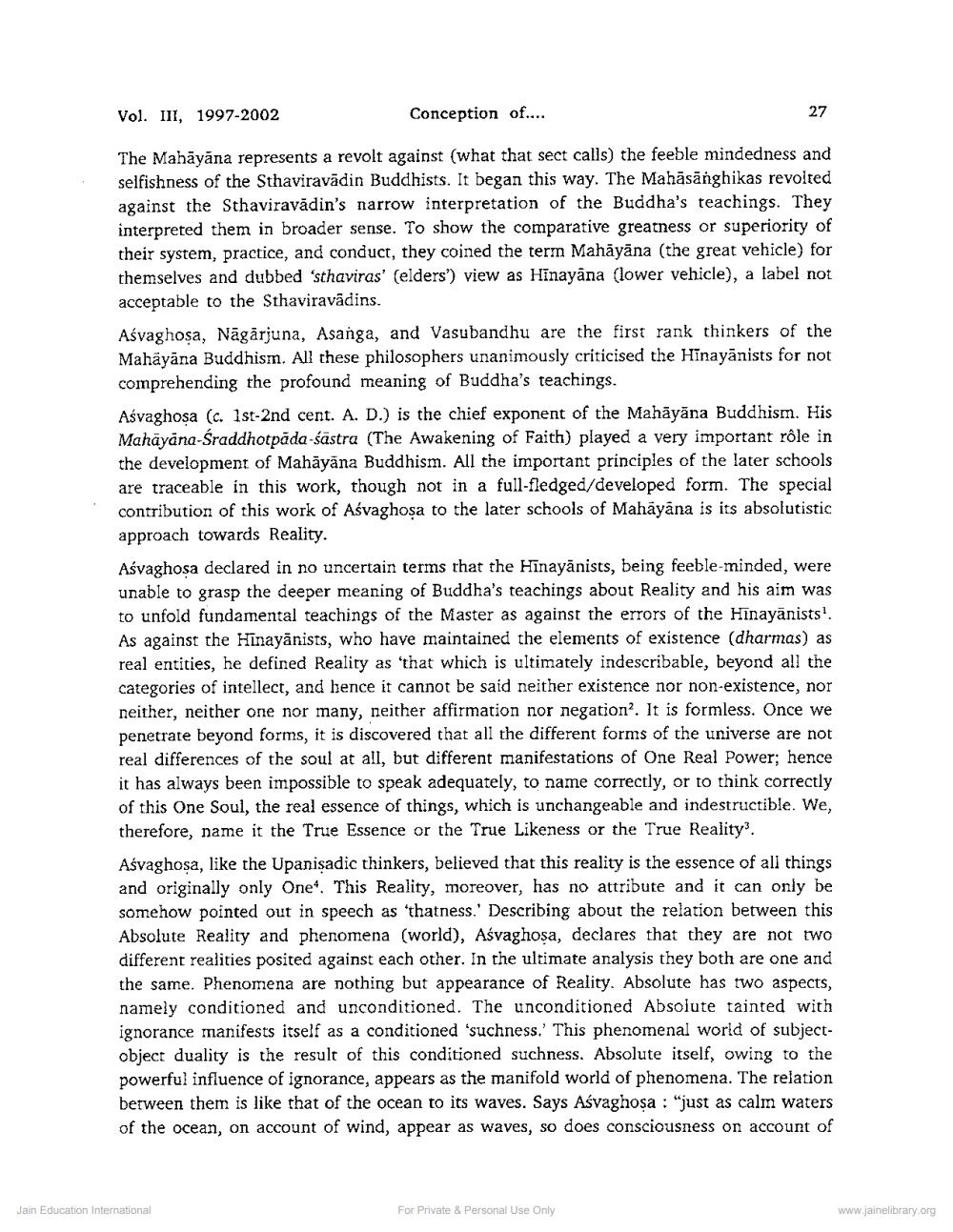Book Title: Conception of Reality in Mahayana Buddhism Author(s): Yajneshwar S Shastri Publisher: Z_Nirgrantha_1_022701.pdf and Nirgrantha_2_022702.pdf and Nirgrantha_3_022703.pdf View full book textPage 2
________________ Vol. III, 1997-2002 Conception of.... 27 The Mahāyāna represents a revolt against (what that sect calls) the feeble mindedness and selfishness of the Sthaviravādin Buddhists. It began this way. The Mahāsānghikas revolted against the Sthaviravādin's narrow interpretation of the Buddha's teachings. They interpreted them in broader sense. To show the comparative greatness or superiority of their system, practice, and conduct, they coined the term Mahāyāna (the great vehicle) for themselves and dubbed 'sthaviras' (elders') view as Hinayāna (lower vehicle), a label not acceptable to the Sthaviravādins. Ašvaghosa, Nāgārjuna, Asanga, and Vasubandhu are the first rank thinkers of the Mahāyāna Buddhism. All these philosophers unanimously criticised the Hinayānists for not comprehending the profound meaning of Buddha's teachings. Ašvaghosa (c. 1st-2nd cent. A. D.) is the chief exponent of the Mahāyāna Buddhism. His Mahāyāna-Śraddhotpada-śāstra (The Awakening of Faith) played a very important role in the development of Mahāyāna Buddhism. All the important principles of the later schools are traceable in this work, though not in a full-fledged/developed form. The special contribution of this work of Ašvaghosa to the later schools of Mahāyāna is its absolutistic approach towards Reality. Aśvaghosa declared in no uncertain terms that the Hinayānists, being feeble-minded, were unable to grasp the deeper meaning of Buddha's teachings about Reality and his aim was to unfold fundamental teachings of the Master as against the errors of the Hinayānists! As against the Hinayānists, who have maintained the elements of existence (dharmas) as real entities, he defined Reality as 'that which is ultimately indescribable, beyond all the categories of intellect, and hence it cannot be said neither existence nor non-existence, nor neither, neither one nor many, neither affirmation nor negation. It is formless. Once we penetrate beyond forms, it is discovered that all the different forms of the universe are not real differences of the soul at all, but different manifestations of One Real Power; hence it has always been impossible to speak adequately, to name correctly, or to think correctly of this One Soul, the real essence of things, which is unchangeable and indestructible. We, therefore, name it the True Essence or the True Likeness or the True Reality3. Aśvaghoșa, like the Upanisadic thinkers, believed that this reality is the essence of all things and originally only One*. This Reality, moreover, has no attribute and it can only be somehow pointed out in speech as 'thatness.' Describing about the relation between this Absolute Reality and phenomena (world), Ašvaghoșa, declares that they are not two different realities posited against each other. In the ultimate analysis they both are one and the same. Phenomena are nothing but appearance of Reality. Absolute has two aspects, namely conditioned and unconditioned. The unconditioned Absolute tainted with ignorance manifests itself as a conditioned 'suchness.' This phenomenal world of subjectobject duality is the result of this conditioned suchness. Absolute itself, owing to the powerful influence of ignorance, appears as the manifold world of phenomena. The relation berween them is like that of the ocean to its waves. Says Aśvaghosa : "just as calm waters of the ocean, on account of wind, appear as waves, so does consciousness on account of Jain Education International For Private & Personal Use Only www.jainelibrary.orgPage Navigation
1 2 3 4 5 6 7 8 9 10 11
